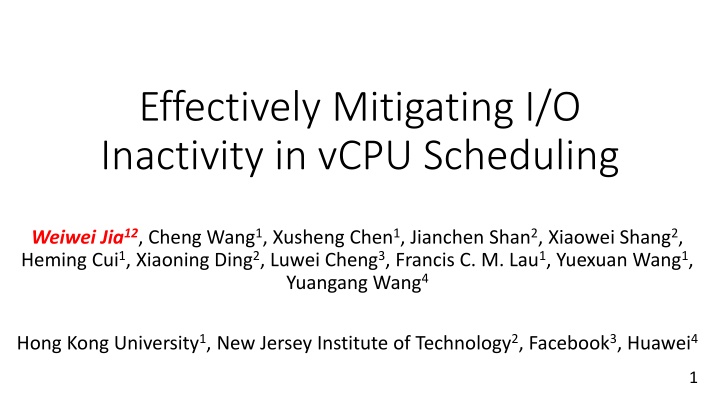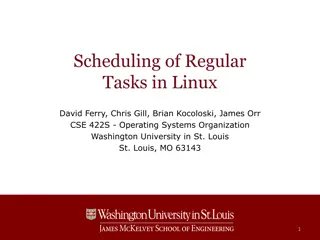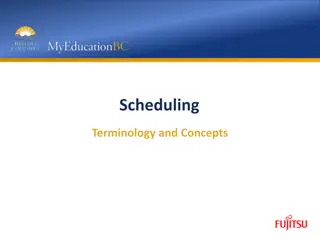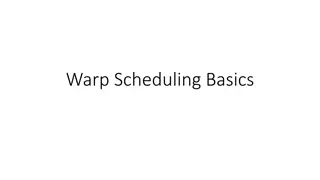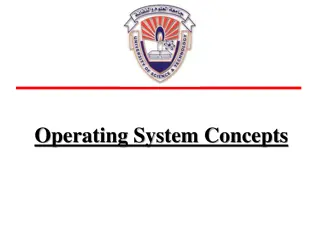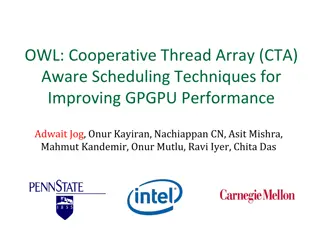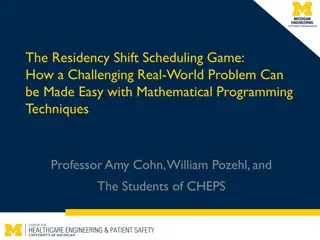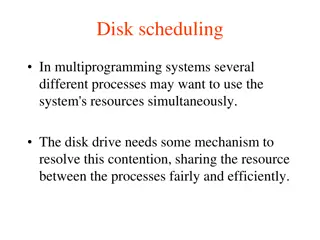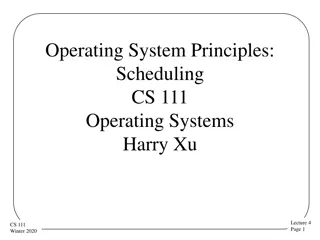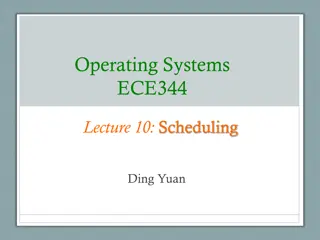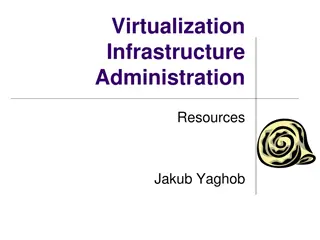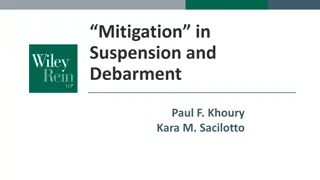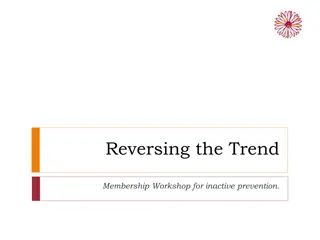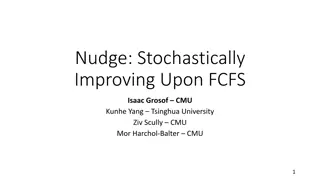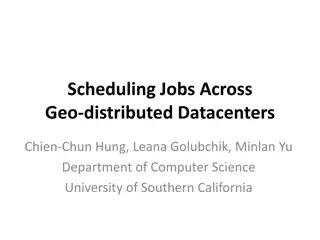Effectively Mitigating I/O Inactivity in vCPU Scheduling
Mitigating I/O inactivity in virtual CPU (vCPU) scheduling is crucial for optimizing performance and resource utilization in cloud environments. This involves efficiently managing virtual machine consolidation, time-sharing vCPUs on physical CPUs, and addressing underutilized I/O devices. Failure to address I/O inactivity can significantly impact VM performance and throughput, leading to inefficient resource usage and decreased system capabilities.
Download Presentation

Please find below an Image/Link to download the presentation.
The content on the website is provided AS IS for your information and personal use only. It may not be sold, licensed, or shared on other websites without obtaining consent from the author.If you encounter any issues during the download, it is possible that the publisher has removed the file from their server.
You are allowed to download the files provided on this website for personal or commercial use, subject to the condition that they are used lawfully. All files are the property of their respective owners.
The content on the website is provided AS IS for your information and personal use only. It may not be sold, licensed, or shared on other websites without obtaining consent from the author.
E N D
Presentation Transcript
Effectively Mitigating I/O Inactivity in vCPU Scheduling Weiwei Jia12, Cheng Wang1, Xusheng Chen1, Jianchen Shan2, Xiaowei Shang2, Heming Cui1, Xiaoning Ding2, Luwei Cheng3, Francis C. M. Lau1, Yuexuan Wang1, Yuangang Wang4 Hong Kong University1, New Jersey Institute of Technology2, Facebook3, Huawei4 1
VM consolidation is pervasive in clouds Physical Machine (PM 1) PMn Virtual Machine (VM 1) . . . VM 2 Virtual Machine Monitor (VMM) Consolidation benefits: Ease management Save energy Improve resource utilization and system throughput 2
Multiple vCPUs are scheduled to time-share a pCPU Physical Machine VM 1 VM 2 vCPU3 vCPU4 vCPU3 vCPU4 vCPU1 vCPU2 vCPU1 vCPU2 VMM pCPU2 pCPU3 pCPU4 pCPU1 Physical CPU (pCPU): hardware resources Virtual CPU (vCPU): processors in VM, threads in VMM Multiple vCPUs sharing one pCPU is often E.g., VMWARE suggests 8-10 vCPUs to share one pCPU 3
Multiple vCPUs are scheduled to time-share a pCPU T0 T1 T2 Physical Machine Time active VM 1 VM 2 vCPU1 in VM1 inactive vCPU3 vCPU4 vCPU3 vCPU4 vCPU1 vCPU2 vCPU1 vCPU2 VMM active pCPU2 pCPU3 pCPU4 pCPU1 vCPU1 in VM2 inactive Physical CPU (pCPU): hardware resources Virtual CPU (vCPU): processors in VM, threads in VMM vCPU scheduler schedules and deschedules vCPUs periodically 4
An understudied problem: I/O inactivity T0 T1 T2 Physical Machine VM 1 Time VM 2 active VM1 vCPU1 activity vCPU3 vCPU4 vCPU3 vCPU4 vCPU1 vCPU2 vCPU1 vCPU2 inactive active VMM HDFS I/O activity on vCPU1 pCPU2 pCPU3 pCPU4 pCPU1 inactive I/O request No I/O requests can be issued on an inactive vCPU Underutilization of I/O device 5
I/O inactivity causes low I/O performance in VMs Physical Machine VM 1 VM 2 vCPU3 vCPU4 vCPU3 vCPU4 vCPU1 vCPU2 vCPU1 vCPU2 VMM pCPU2 pCPU3 pCPU4 pCPU1 VM1 can only use 50% of I/O bandwidth even when VM2 does not use I/O device. I/O throughput of HDFS in VM1 is only 55% of that on bare-metal. 6
I/O scheduler cannot effectively enforce fairness between VMs Physical Machine Operating System pCPU2 pCPU3 pCPU4 pCPU1 Two I/O-intensive applications (HDFS and MongoDB) show similar I/O throughput on bare-metal 7
I/O scheduler cannot effectively enforce fairness between VMs Physical Machine VM 1 VM 2 vCPU3 vCPU4 vCPU3 vCPU4 vCPU1 vCPU2 vCPU1 vCPU2 VMM pCPU2 pCPU3 pCPU4 pCPU1 VM1 and VM2 are assigned with the same I/O priority, but MongoDB (VM2) achieves much higher I/O throughput. vCPUs running I/O tasks in MongoDB in VM2 have more time slice to run. vCPUs running HDFS in VM1 have less time slice to run 8
Key: decouping I/O activities from vCPU scheduling I/O request active active Blue line: vCPU activity Vanilla KVM inactive inactive Black line: I/O activity inactive inactive inactive inactive vSlicer[HPDC 12] xBalloon[SoCC 17] inactive inactive I/O activity bare-metal 9
Can we decouple I/O activities from vCPU scheduling? Our answer is YES! Key observation: each VM often has active vCPUs Solution: keep I/O tasks on active vCPUs - Migrate an I/O task when its vCPU is about to be descheduled - Migrate the I/O task to a vCPU that is NOT to be descheduled soon. Benefits: I/O tasks can make continuous progress like on bare-metal - Migration can be efficient because I/O tasks usually have small working sets. 10
vMigrater: a user-level design I/O-boundTask VM CPU-boundTask Task Detector vCPU Monitor To be descheduled vMigrater T0 T2 T1 T1 TaskMigrater Time active vCPU1 activity vCPU1 vCPU2 vCPU3 inactive Hypervisor vCPUScheduler vCPU3 activity pCPU2 pCPU1 NOT to be descheduled soon. 11
Challenges with the user-level design (1/3) - How to detect I/O tasks quickly? Existing resource monitors cannot respond to execution phase changes quickly - eg., Linux top and iotop refresh measurements periodically every a few seconds - Applications often have bursty I/O phases finished within a refreshing period. Event-driven method in vMigrator - Monitor I/O events time at OS block I/O layer - Calculate the fraction between the I/O events time and the whole period - respond quickly when task becomes I/O intensive (<1 millisecond) 12
Implementation challenges (2/3) - when to migrate? When the vCPUs are to be inactive Na ve approach: monitor inactive/active vCPUs in hypervisor layer: not secure and portable Our approach - a heartbeat-like mechanism: timer events as heartbeats - a vCPU cannot process timer events when it is inactive - vCPU time slice: timer differences between the start timer and end timer when the vCPU is active 13
Challenges with the user-level design (3/3) - migrate to which vCPU(s)? Migrate to vCPUs with enough remaining time slice Estimation of time slice still relies on the heartbeat-like mechanism Na ve approach: consolidate all I/O tasks to the vCPU with the longest remaining time slice - Problem: the vCPU may be overloaded Our approach: distribute I/O tasks to vCPUs based on I/O workload and remaining time slice. - tasks with heavier I/O workload on vCPUs with more time slice 14
Experimental Setup Dell PowerEdge R430 with 12 cores, a 1TB HDD, and a 1TB SSD Both VMs and VMM (linux QEMU/KVM) use Ubuntu Linux 16.04 Each VM has 12 vCPUs and 4GB DRAM Compared with vSlicer [HPDC 12] and xBalloon [SoCC 17] 15
Evaluation applications and workloads Application Workload HDFS Sequentially read 16GB with HDFS TestDFSIO LevelDB Randomly scan table with db_bench MediaTomb Concurrent requests on teanscoding a 1.1GB video HBase Randomly read 1GB with Hbase PerfEval PostMark Concurrent requests on a mail server Nginx Concurrent requests on watermarking images MongDB Sequentially scan records with YCSB 16
Evaluation questions How much performance improvement can be achieved with vMigrater, compared with vanilla KVM and two related systems? Can vMigrater help the I/O scheduler in the VMM to achieve fairness between VMs? How robust is vMigrater to varying workloads? What is the overhead incurred by vMigrater? What is vMigrater s performance when the workload in a VM varies over time How does vMigrater scale to the number of shared vCPUs on a pCPU? 17
Throughput on seven applications (4 vCPUs sharing per pCPU) vMigrater s throughput is 192% higher than Vanilla KVM, 75% higher than vSlicer, 84% higher than xBalloon on average 18
HDFS performance analysis HDFS Vanilla vSlicer xBalloon vMigrater I/O inactivity time (seconds) 121.82 92.91 75.27 6.62 19
MediaTomb performance analysis HDFS Vanilla vSlicer xBalloon vMigrater I/O inactivity time (seconds) 121.82 92.91 75.27 6.62 MediaTomb Vanilla vSlicer xBalloon vMigrater I/O inactivity time (seconds) 108.61 89.46 116.96 34.95 vMigrater has big I/O inactivity periods on MediaTomb MediaTomb combine computation and I/O in each thread so the migration cost is higher 20
Fairness of I/O Scheduler in VMM Physical Machine VM 1 VM 2 vCPU3 vCPU4 vCPU3 vCPU4 vCPU1 vCPU2 vCPU1 vCPU2 VMM pCPU2 pCPU3 pCPU4 pCPU1 21
Robustness to varying workloads Added 16 clients Added 4 clients Added 8 clients 22
Conclusions I/O inactivity problem - Performance degradation - I/O scheduler unfairness vMigrater: effectively mitigating I/O inactivity problem - Performance is close to bare-metal - Regain fairness vMigrater s source code: https://github.com/hku-systems/vMigrater 23
Thank you Questions? 24
